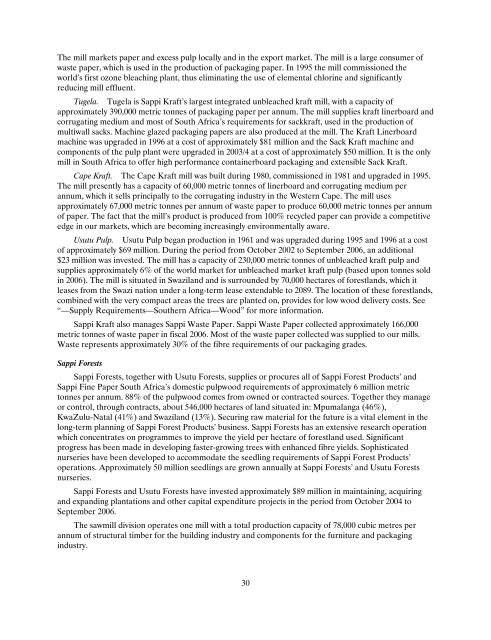You also want an ePaper? Increase the reach of your titles
YUMPU automatically turns print PDFs into web optimized ePapers that Google loves.
The mill markets paper and excess pulp locally and in the export market. The mill is a large consumer of<br />
waste paper, which is used in the production of packaging paper. In 1995 the mill commissioned the<br />
world’s first ozone bleaching plant, thus eliminating the use of elemental chlorine and significantly<br />
reducing mill effluent.<br />
Tugela. Tugela is <strong>Sappi</strong> Kraft’s largest integrated unbleached kraft mill, with a capacity of<br />
approximately 390,000 metric tonnes of packaging paper per annum. The mill supplies kraft linerboard and<br />
corrugating medium and most of South Africa’s requirements for sackkraft, used in the production of<br />
multiwall sacks. Machine glazed packaging papers are also produced at the mill. The Kraft Linerboard<br />
machine was upgraded in 1996 at a cost of approximately $81 million and the Sack Kraft machine and<br />
components of the pulp plant were upgraded in <strong>20</strong>03/4 at a cost of approximately $50 million. It is the only<br />
mill in South Africa to offer high performance containerboard packaging and extensible Sack Kraft.<br />
Cape Kraft. The Cape Kraft mill was built during 1980, commissioned in 1981 and upgraded in 1995.<br />
The mill presently has a capacity of 60,000 metric tonnes of linerboard and corrugating medium per<br />
annum, which it sells principally to the corrugating industry in the Western Cape. The mill uses<br />
approximately 67,000 metric tonnes per annum of waste paper to produce 60,000 metric tonnes per annum<br />
of paper. The fact that the mill’s product is produced from 100% recycled paper can provide a competitive<br />
edge in our markets, which are becoming increasingly environmentally aware.<br />
Usutu Pulp. Usutu Pulp began production in 1961 and was upgraded during 1995 and 1996 at a cost<br />
of approximately $69 million. During the period from October <strong>20</strong>02 to September <strong><strong>20</strong>06</strong>, an additional<br />
$23 million was invested. The mill has a capacity of 230,000 metric tonnes of unbleached kraft pulp and<br />
supplies approximately 6% of the world market for unbleached market kraft pulp (based upon tonnes sold<br />
in <strong><strong>20</strong>06</strong>). The mill is situated in Swaziland and is surrounded by 70,000 hectares of forestlands, which it<br />
leases from the Swazi nation under a long-term lease extendable to <strong>20</strong>89. The location of these forestlands,<br />
combined with the very compact areas the trees are planted on, provides for low wood delivery costs. See<br />
“—Supply Requirements—Southern Africa—Wood” for more information.<br />
<strong>Sappi</strong> Kraft also manages <strong>Sappi</strong> Waste Paper. <strong>Sappi</strong> Waste Paper collected approximately 166,000<br />
metric tonnes of waste paper in fiscal <strong><strong>20</strong>06</strong>. Most of the waste paper collected was supplied to our mills.<br />
Waste represents approximately 30% of the fibre requirements of our packaging grades.<br />
<strong>Sappi</strong> Forests<br />
<strong>Sappi</strong> Forests, together with Usutu Forests, supplies or procures all of <strong>Sappi</strong> Forest Products’ and<br />
<strong>Sappi</strong> Fine Paper South Africa’s domestic pulpwood requirements of approximately 6 million metric<br />
tonnes per annum. 88% of the pulpwood comes from owned or contracted sources. Together they manage<br />
or control, through contracts, about 546,000 hectares of land situated in: Mpumalanga (46%),<br />
KwaZulu-Natal (41%) and Swaziland (13%). Securing raw material for the future is a vital element in the<br />
long-term planning of <strong>Sappi</strong> Forest Products’ business. <strong>Sappi</strong> Forests has an extensive research operation<br />
which concentrates on programmes to improve the yield per hectare of forestland used. Significant<br />
progress has been made in developing faster-growing trees with enhanced fibre yields. Sophisticated<br />
nurseries have been developed to accommodate the seedling requirements of <strong>Sappi</strong> Forest Products’<br />
operations. Approximately 50 million seedlings are grown annually at <strong>Sappi</strong> Forests’ and Usutu Forests<br />
nurseries.<br />
<strong>Sappi</strong> Forests and Usutu Forests have invested approximately $89 million in maintaining, acquiring<br />
and expanding plantations and other capital expenditure projects in the period from October <strong>20</strong>04 to<br />
September <strong><strong>20</strong>06</strong>.<br />
The sawmill division operates one mill with a total production capacity of 78,000 cubic metres per<br />
annum of structural timber for the building industry and components for the furniture and packaging<br />
industry.<br />
30
















